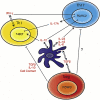Translational mini-review series on Th17 cells: function and regulation of human T helper 17 cells in health and disease
- PMID: 19912252
- PMCID: PMC2810379
- DOI: 10.1111/j.1365-2249.2009.04037.x
Translational mini-review series on Th17 cells: function and regulation of human T helper 17 cells in health and disease
Abstract
T helper (Th) cell have a central role in modulating immune responses. While Th1 and Th2 cells have long been known to regulate cellular and humoral immunity, Th17 cells have been identified only recently as a Th lineage that regulates inflammation via production of distinct cytokines such as interleukin (IL)-17. There is growing evidence that Th17 cells are pathological in many human diseases, leading to intense interest in defining their origins, functions and developing strategies to block their pathological effects. The cytokines that regulate Th17 differentiation have been the focus of much debate, due primarily to inconsistent findings from studies in humans. Evidence from human disease suggests that their in vivo development is driven by specialized antigen-presenting cells. Knowledge of how Th17 cells interact with other immune cells is limited, but recent data suggest that Th17 cells may not be subject to strict cellular regulation by T regulatory cells. Notably, Th17 cells and T regulatory cells appear to share common developmental pathways and both cell types retain significant plasticity. Herein, we will discuss the molecular and cellular regulation of Th17 cells with an emphasis on studies in humans.
Figures



References
-
- Abbas AK, Murphy KM, Sher A. Functional diversity of helper T lymphocytes. Nature. 1996;383:787–93. - PubMed
-
- Glimcher LH, Murphy KM. Lineage commitment in the immune system: the T helper lymphocyte grows up. Genes Dev. 2000;14:1693–711. - PubMed
-
- Harrington LE, Hatton RD, Mangan PR, et al. Interleukin 17-producing CD4+ effector T cells develop via a lineage distinct from the T helper type 1 and 2 lineages. Nat Immunol. 2005;6:1123–32. - PubMed
-
- Bettelli E, Oukka M, Kuchroo VK. T(H)-17 cells in the circle of immunity and autoimmunity. Nat Immunol. 2007;8:345–50. - PubMed
Publication types
MeSH terms
Substances
LinkOut - more resources
Full Text Sources
Other Literature Sources

